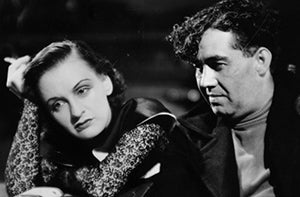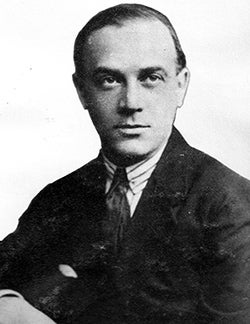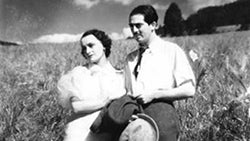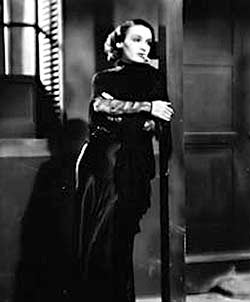It never ceases to amaze me that after forty years as a film historian, I still discover films that knock me out, especially from corners I least expect it. Such is the case with Arcady Boytler’s 1934 masterpiece, The Woman of the Port (La mujer del Puerto), starring Andrea Palma and Domingo Soler, both of whom would go on to long and illustrious careers in Mexican cinema. An outrageous melodrama, The Woman of the Port, mixes overwrought emotions with highly-stylized Expressionist images, recalling Weimar cinema and Soviet-style montage, managing to be both wildly popular at the box office and avant-garde at the same time.

Based on Guy de Maupassant’s 1889 short story, “Le Port,” and Leo Tolstoy’s version of the same story, “Francoise” (1891), the film is divided into roughly two parts. The first half tells the story of Rosario, who lives with her widowed and ill father, Don Antonio, but is in love with her young neighbor, who turns out to be a cad; he accidentally kills the father, leaving Rosario without any means of support. The second half finds Rosario working the port of Veracruz as a prostitute, where she picks up a sailor and beds him, only to realize the next morning that he is her long lost brother. Distraught over her inadvertent incest, Rosario throws herself from a pier and drowns.
A number of Mexican film historians identify The Woman of the Port as the film that initiated the golden age of Mexican melodrama, including Gustavo Garcia, Eduardo de la Vega Alfaro, and Paulo Antonio Paranagua. I find no mention of the title, however, in the works of classic film historians, like Georges Sadoul, Maurice Bardèche & Robert Brasillach, Paul Rotha, or David Robinson, pointing to a long-standing blind spot in film studies to classic Latin American cinemas. UCLA Film & Television Archive did show the film in the 1990s in its Mexican Cinema Project, while Arturo Rispstein’s 1991 remake brought the earlier version to consciousness of Cannes Film Festival goers.

Arcady Boytler was seemingly one of those cosmopolitan directors who made films around the globe and thus fell through the cracks of film history, much like Paul Fejos, because he couldn’t be placed in a national cinema. Born in Russia in 1890 of Jewish parentage, Boytler started in the theatre as an actor with Stanislavski, while making short comedy films before the 1917 revolution. After the Bolshevik revolution, he emigrated to Germany, where between 1921 and 1923, he appeared in four short films as a title character named Boytler. After touring with a French theatre company, he directed his first feature in Chile in 1927, appeared in Spanish language shorts in New York in 1930, then became friends with Sergei Eisenstein and reportedly appeared in the aborted Que Vive Mexico! In 1932 he began directing shorts and features in Mexico, eventually retiring in 1945 to operate a movie theater. His third feature, The Woman of the Port, was clearly influenced by both F.W. Murnau and Eisenstein.
The film opens with an extravagant and highly romanticized scene of the young lovers center frame, lying in an endless field of flowers, then has them frolic over hill and dale (strongly reminiscent of People on Sunday (1929)). The sequence ends with the lovers peering from a mountain top, shot against backlighted clouds, an image straight out of an Arnold Fanck mountain film. Reality sets in immediately, though, when Rosario visits her ailing father in the mortuary, where he fabricates coffins.

High key, expressionist lighting, expertly crafted by Alex Phillips, informs the following Carnival scene, where the boyfriend picks up another girl, while Rosario tends to her sick father and deals with the local busybodies in their apartment complex, the lighting signaling the film’s darkening mood. The courtyard, where Don Antonio tumbles down the stairs to his death, while three old women peer from their respective windows is strongly reminiscent of similar interactions between neighbors in Murnau’s The Last Laugh (1925). The later bar and brothel scenes at the Salon Nicanor, then, are pure Expressionism, while Boytler’s editing orchestrates a symphony of looks, wordlessly expressing fear and desire. Rosario, now all in black satin, appears in a dissolve from nowhere, moving like Marlene Dietrich, a strangely disengaged lady of the night. Only the looks exchanged between Rosario and a sailor, are erotically charged, making the revelation of incest as difficult for the audience as for the perpetrators.

Then there are montage sequences of pure spectacle, such as the Vera Cruz Mardi Gras scenes, which take on a surrealistic aspect when they are intercut with Don Antonio’s funeral, or the Vera Cruz harbor scenes that look like a new realist documentary by Walter Ruttmann, with freighters docking, sailors hauling in anchors, etc. These breaks in the narrative, as well as numerous other narrative ellipses leave enough space for the audience to supply their strong own emotions to this tale of social ostracism and taboo violation, turning The Woman of the Port into one of the Mexican cinema’s greatest box office successes.






 Mobile Navigation
Mobile Navigation


Comments